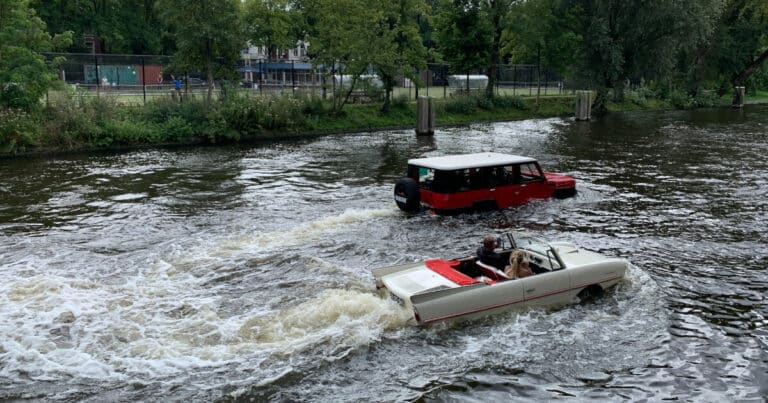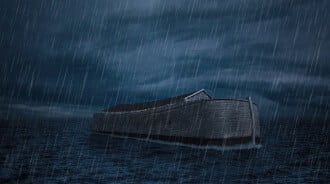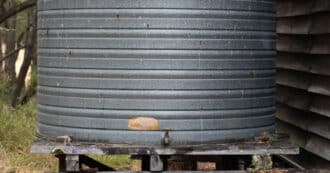By Yonatan Neril and Elisheva Malomet – Flash floods can occur in as little as minutes or an hour, but their devastation can last months or decades. Triggered and intensified by climate change, deforestation, development and more, flash floods destroy homes, infrastructure, human lives and the environment.
Flash floods occur worldwide, mostly due to heavy rainfall over a short period of time during storms, U.S. National Weather Service notes. I have survived flash floods on two continents, while tragically, many lives are lost in floods. In northern India, I ran for my life uphill when a river swelled from torrential rain. Part of the village where I had just been could be seen flowing downstream in the floodwaters. In New Jersey, I was on a main street when water started rising fast, as I describe in a related blog post.
In this post, we’ll discuss how flash floods happen and what their impacts are on society and the environment. We’ll also explore the Biblical story of Noah’s Ark featuring an apocalyptic flood.
Why are Flash Floods Happening More Now?
While flash floods have occurred for time immemorial, today they’re exacerbated by two human caused factors.
First, flash flooding is more extreme due to climate change. Human burning of fossil fuels and rainforests raises our planet’s average annual global temperature.
The Center for Climate and Energy Solutions notes: “In the U.S., the Midwest and Northeast have seen the strongest increases in heavy precipitation events. Warmer air can hold more water vapor. For each degree of warming, the air’s capacity for water vapor goes up by about 7 percent. An atmosphere with more moisture can produce more intense precipitation events, which is exactly what has been observed.”
Flash floods may see random, but they’ve become consistently more destructive due to global warming. We are increasingly vulnerable to natural disasters that are no longer “natural,” but human caused.
Why might we care about flash flooding? Because of the threat to us, our community, other people, and animals and plants of many species. It’s not only people near coastlines and major rivers who face flash floods. People, plants, and animals near quiet streams and lakes, and in major downtown areas, can all be impacted.
When flash floods overwhelm natural and human made bodies of water, floodwaters turn major roads and entire neighborhoods into temporary rivers and lakes. Fast flowing water can overflow a simple streambed or burst into someone’s living room! Flash floods also oversaturate the ground and can cause landslides. The damage can shut down power sources and cut people off from emergency services.
Higher Risk of Flood Damage in Urban Areas
A second human-caused factor in increased flash flood risk is rapid expansion of urban areas in recent decades.
A flood’s severity is greatly determined by the landscape. Floods can rapidly develop in urban areas due to impermeable pavement on city roads. Unable to soak into the earth, water builds on top of roads and can turn major highways into fast-moving streams.
Human vulnerability to flash floods has additionally increased due to poor drainage planning for communities, and housing development in areas that are no longer truly “100-year” flood zones. Recent hurricanes that flooded areas of New Orleans and Houston illustrated this danger. Flooding was far more severe than it might have been before all the urban expansion.
Impermeable Pavement and Floods
As cities and suburbs have expanded into what were floodplains, more and more land that was farms, swamps, and wetlands has been drained and covered with impermeable asphalt.
This paving makes it much harder for water to filter into natural watersheds, and so this water becomes runoff. Soil in the remaining unpaved land areas can only absorb so much rain before becoming saturated, and the excess water must keep moving somewhere.
The Disastrous Effects of Runoff
When rain is no longer captured in natural or human made catchments, like rivers or reservoirs, water runs off into already overloaded paved systems and underground sewer systems.
Runoff can harm the environment by carrying dangerous objects and materials, and toxic pollutants. When floodwaters drain away, many a new problem is left behind.
Silt and mud may cover streets and fill the bottom floors of houses and buildings. Large debris, sewage, and chemicals from damaged industrial plants can enter the drinking water systems. Mold from persistent dampness can develop in homes. All these degrade and endanger communities, and render rebuilding extremely difficult.
The Deadly Impact of Flash Floods
Floods are the most deadly natural disasters in the United States. With huge amounts of powerful water rapidly flowing and moving objects, even as large as cars, dwellings can be damaged beyond repair and infrastructure made unusable for long periods.
Flash floods cause destruction, death, and massive financial damage. People in poorer areas, even within wealthy cities, often have no flood insurance and may lose everything. When the financial cost of hurricanes and slower moving floods is included, the full toll skyrockets. Even help from national and international government and rescue agencies never covers the true price of what is lost.
Emotional impact of flash floods
Flooding has real and traumatic emotional impact too. The New York Times quoted Maya Wadler, a teenager in Houston, Texas, as she recalled the moments her family’s home flooded in 2017. “I usually just trust my parents that everything is going to be okay. But I looked up, and I saw that my dad was closing his eyes, the water was getting in his eyes. And I just thought: He has absolutely no idea where we are going to go.” By 2019, Houston flooded for the third time in three years.
What can we do to mitigate flash flooding?
Making changes to our homes and communities can help reduce the impact of flash flooding. Homeowners and local governments can create natural buffers by planting trees, shrubs, or grasses in a community’s watersheds, so more runoff water can enter the watershed and percolate through the soil before reaching homes or businesses.
Creating swales, or shallow channels with gently sloping sides, also offers drainage during heavy rainfall events. These channels help slow down the flow of rain from higher to lower elevations, preventing flooding downstream.
Trenches filled with gravel are another option for storing excess stormwater before it overflows onto streets and into neighborhoods. Citizens can ask their local government to undertake such measures.
Protect and Preserve and Restore Floodplains
The best overall strategy is to ensure that natural wetlands, rivers, lakes, and aquifers are protected and preserved to absorb their full capacity of water during storms. A critical preventative measure to mitigate flood damage is protect floodplains, the natural barriers between bodies of water and dry land.
These essential areas must be preserved or restored to help lessen impacts of flooding. Sprawling cities with buildings, infrastructure, and endless acres of pavement on floodplains increase the severity of flooding triggered by climate change.
A Natural Flood Protection Success Story
The city of Napa, California, is a success story in its approach following a devastating flood in 1986, the 30th flood in 150 years. They looked at flood control from a broader and more comprehensive perspective. As Kaitlin Almack wrote, “The goal of the “living river” initiative is to increase the river’s capacity to handle flood waters while maintaining and restoring the original shape and alignment. Engineers replaced high floodwalls and levees with terraced marshes and wider wetland barriers…”
Noah Also Prepared for a Flood
I wonder what Noah, survivor of the first flood recounted in the Bible, would think of the increasingly frequent flash floods that occur in our time. Would he relate to the causes and impacts, and to attitudes people now hold about flooding? Would he think we are being punished by flood, as the Bible says people were in his time? Could he help us understand how to survive?
The flood and Noah’s ark are parts of one of the best known Biblical stories—a parable for how to live with water and disaster without being defeated by them.
In Genesis 7:9, God chose to save Noah because he was “righteous.” In preparation for the flood, Noah took precautionary measures that can teach us. He made himself and his family a shelter in the ark, as a refuge from God’s impending judgment, but he also made sure to account for the survival of other living creatures. From Noah’s consciousness and righteousness we can learn about the importance of helping people and all species.
How does our situation with floods today relate?
As I write in Eco Bible, the Ark was Noah’s difficult but necessary solution to a “global” crisis. Noah had warning from God, and responded by maintaining his faith and meeting every challenge. We have warnings now, and must meet them with spiritual commitment as well as technological innovation.
For decades, scientists have provided us with warnings that flash floods will become worse if we don’t change our fossil fuel intensive lifestyle. Like Noah, we must meet this global challenge as well as strive for a better tomorrow. This includes educating others about environmental issues and ensuring that our actions on every level make a difference.
Making a Difference to Stop Flash Floods
Making more environmentally conscious choices, like fueling our lives with wind and solar power, can influence not only our own lives but the lives of those around us. Protecting wetlands, floodplains, and topsoils can protect us from flash floods. If we make efforts to stop global warming, reduce greenhouse gas emissions, and educate about climate change, all of these can reduce flood danger as well.
Summing Up on Flash Floods
It is important to remember we are not alone. Just like Noah, we can be righteous in this generation. As weather events get increasingly extreme and natural disasters have irreversible impacts, we must hold ourselves responsible and accountable for the environment, our common home.
Taking actions in our lives that benefit the environment now and for generations to come is incredibly important. Engaging people and educating them and ourselves about these issues is a powerful place to start.
* Featured image source





